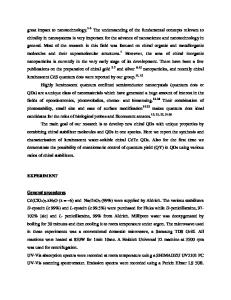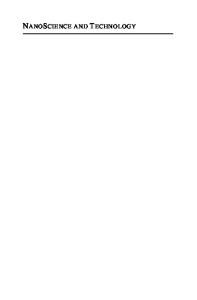Quantum Dots and Quantum Rods
Quantum Dots are tiny nanocrystals of a few nanometers in size. Due to their unique optical and electronic properties they are one of the core issues in the field of nanotechnology. This chapter will cover fundamental facts of Quantum Dots and the state o
- PDF / 564,455 Bytes
- 23 Pages / 439.37 x 666.142 pts Page_size
- 110 Downloads / 428 Views
Quantum Dots and Quantum Rods Christin Rengers, Nikolai Gaponik and Alexander Eychmüller
Abstract Quantum Dots are tiny nanocrystals of a few nanometers in size. Due to their unique optical and electronic properties they are one of the core issues in the field of nanotechnology. This chapter will cover fundamental facts of Quantum Dots and the state of research of preparation methods and surface architectures. Section 2.1 will summarize the historical development of the field of nanotechnology and give a short introduction on Quantum Dots. The electronic structure and resultant optical properties are discussed in Sect. 2.2. The importance of the surface chemistry on the Quantum Dots functionality and optical properties will be explained in Sect. 2.3. Section 2.3.1 outlines the fundamental preparation methods and state of the art techniques in aqueous media and in organic solvents. Nanostructures of other geometries including their optical and electronic characteristic will be described in Sect. 2.4.
2.1 Introduction The foundation for the development of the field of nanotechnology was laid by the speech of Richard Feynman “There is plenty of room at the bottom” in 1959, in which he spoke about the principles of miniaturization as low as to the atomic level. The term “nanotechnology” itself was first introduced by Taniguchi 1974, whereas first attempts towards the synthesis of semiconductor nanomaterials were done by Ekimov [1], Grätzel [2], Henglein [3] as well as Rosetti and Brus [4] in the early 1980s. In 1982, Efros and Efros [5] developed an idealized model to study the light absorption in semiconductor spheres. Postulating that the quantum size effect could be used to control the colour of the crystallites by changing their size or stoichiometry, C. Rengers · N. Gaponik · A. Eychmüller (B) Physical Chemistry, Technical University of Dresden, Bergstrasse 66b, 01069 Dresden, Germany e-mail: [email protected] C. Rengers e-mail: [email protected] N. Gaponik e-mail: [email protected] © Springer Nature Switzerland AG 2019 P. Gehr and R. Zellner (eds.), Biological Responses to Nanoscale Particles, NanoScience and Technology, https://doi.org/10.1007/978-3-030-12461-8_2
29
30
C. Rengers et al.
Fig. 2.1 Schematic illustration of the band structure of a semiconductor in comparison to insulators and conductors. The band gap of a semiconductor, which is the distance between the electron filled valence band (dark grey) and the empty conduction band (light grey) can be overcome by an electron upon absorption of a photon. A positively charged hole is left in the valence band, when the electron is excited to the conduction band. In the case of insulators, the band gap is unsurmountable high for electrons, whereas the valence band and conduction band of conductors overlap resulting in permanent electrical conductivity
they laid the foundation for the research on semiconductor quantum dots (QDs). The field of light-emitting semiconductor nanoparticles has experienced an e
Data Loading...









